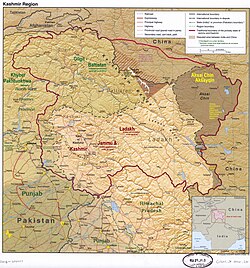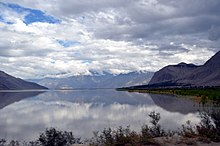| Skardu District ضلع سکردو | |
|---|---|
| District of Gilgit-Baltistan administered by Pakistan | |
 Halma Ranga Halma Ranga | |
| Interactive map of Skardu district | |
 A map showing Pakistani-administered Gilgit-Baltistan (shaded in sage green) in the disputed Kashmir region A map showing Pakistani-administered Gilgit-Baltistan (shaded in sage green) in the disputed Kashmir region | |
| Coordinates: 35°17′25″N 75°38′40″E / 35.29028°N 75.64444°E / 35.29028; 75.64444 | |
| Administering country | Pakistan |
| Territory | Gilgit-Baltistan |
| Division | Baltistan Division |
| Headquarters | Skardu |
| Government | |
| • Type | District Administration |
| • Deputy Commissioner | Karimdad Chugtai (PAS) |
| • District Police Officer | Hassan Ali (PSP) |
| • District Health Officer | N/A |
| Area | |
| • Total | 15,000 km (6,000 sq mi) |
| Population | |
| • Total | 214,848 |
| Number of tehsils | 4 |

The Skardu District (Urdu: ضلع سکردو) is a district of Pakistan-administered Gilgit-Baltistan in the disputed Kashmir region. Skardu District is bounded on the east by the Ghanche District, on the south by the Kharmang District, on the west by the Astore District, on the north-west by the Rondu District and on the north by the Shigar district. The district headquarters is the town of Skardu, which is also the division headquarters.

Mountain peaks and glaciers
The highest peak in Skardu District is K2 (8,611 m), which is the highest peak in Pakistan and the second-highest in the world. The Baltoro Muztagh, the subrange of the Karakoram Mountains that includes the mighty peaks of K2 (8,611 m), Broad Peak (8,047 m), the Gasherbrums (8,000+ m), and Masherbrum (7,821 m), is located in Skardu District. Askole is the last settlement in the district for all treks to Concordia (the confluence of the Baltoro Glacier and the Godwin-Austen Glacier). The Biafo Glacier and a major part of the Hispar Glacier are also located in the Skardu District.

Education
According to the Alif Ailaan Pakistan District Education Rankings 2015, the Skardu District is ranked 14th out of 148 districts of Pakistan in terms of education. For facilities and infrastructure, the district is ranked 89th out of 148 districts.
Deosai National Park
The Deosai Plateau is one of the highest plateaus in the world which in fall under the jurisdiction of Skardu District. Since centuries the people of Skardu including Sadpara Village, and Yultar Area (Newranga, Astana, Kushmara, Fapa, Kharpito etc) use Deosai as pasture land in summers for grazing there domesticated animals. The Deosai Plateau is the second- highest plateau in the world, after the Tibet Plateau. Famous places in the Deosai National Park are, Chogo Chu (Bara Pani), Naqpo Chu (Kala Pani), Shatong Nala, Sheosar Tso (Lake).
Major towns
The major towns of Skardu District are:- Newranga, Hussainabad, Sadpara, Gamba, Kowardo, Qomrah, Sermik, Chunda, Tandal, Thorgu, Narh, Gol, Koshmara, Atana, Rgya Yul, Sondus, Kharpito, Fapa, Katpana, Shagharthang, Sok, Hoto, Shilla, Shigari Bala ,Basho, Kachura and Skardu town areas including Olding, Khargrong, Sakmaidan, Yultar, Haji Gam, Hassan Colony, Manthal, and Chumik.
Demography
People of the Skardu District are predominantly of the Shia sect of Islam, where 97% of the people are of the Shia sect, 2% are of the Noorbakshi sect, and 1% are of the Sunni sect.
Lakes
The main lakes in the district are:
- Foroq Tso (Kachura Lake)
- Sadpar Tso (Satpara Lake)
- Kachura Tso (Shangrila Lake)
- Sheosar Tso (Sheosar Lake)
- Snow Lake
Mountain passes
The Gondogoro Pass and Burgy La (Burgy Pass) is located in the Skardu District.
See also
References
- ^ The application of the term "administered" to the various regions of Kashmir and a mention of the Kashmir dispute is supported by the tertiary sources (a) through (d), reflecting due weight in the coverage. Although "controlled" and "held" are also applied neutrally to the names of the disputants or to the regions administered by them, as evidenced in sources (f) through (h) below, "held" is also considered politicized usage, as is the term "occupied," (see (i) below).
(a) Kashmir, region Indian subcontinent, Encyclopaedia Britannica, retrieved 15 August 2019 (subscription required) Quote: "Kashmir, region of the northwestern Indian subcontinent ... has been the subject of dispute between India and Pakistan since the partition of the Indian subcontinent in 1947. The northern and western portions are administered by Pakistan and comprise three areas: Azad Kashmir, Gilgit, and Baltistan, the last two being part of a territory called the Northern Areas. Administered by India are the southern and southeastern portions, which constitute the state of Jammu and Kashmir but are slated to be split into two union territories.";
(b) Pletcher, Kenneth, Aksai Chin, Plateau Region, Asia, Encyclopaedia Britannica, retrieved 16 August 2019 (subscription required) Quote: "Aksai Chin, Chinese (Pinyin) Aksayqin, portion of the Kashmir region, at the northernmost extent of the Indian subcontinent in south-central Asia. It constitutes nearly all the territory of the Chinese-administered sector of Kashmir that is claimed by India to be part of the Ladakh area of Jammu and Kashmir state.";
(c) "Kashmir", Encyclopedia Americana, Scholastic Library Publishing, 2006, p. 328, ISBN 978-0-7172-0139-6 C. E Bosworth, University of Manchester Quote: "KASHMIR, kash'mer, the northernmost region of the Indian subcontinent, administered partlv by India, partly by Pakistan, and partly by China. The region has been the subject of a bitter dispute between India and Pakistan since they became independent in 1947";
(d) Osmańczyk, Edmund Jan (2003), Encyclopedia of the United Nations and International Agreements: G to M, Taylor & Francis, pp. 1191–, ISBN 978-0-415-93922-5 Quote: "Jammu and Kashmir: Territory in northwestern India, subject to a dispute betw een India and Pakistan. It has borders with Pakistan and China."
(e) Talbot, Ian (2016), A History of Modern South Asia: Politics, States, Diasporas, Yale University Press, pp. 28–29, ISBN 978-0-300-19694-8 Quote: "We move from a disputed international border to a dotted line on the map that represents a military border not recognized in international law. The line of control separates the Indian and Pakistani administered areas of the former Princely State of Jammu and Kashmir.";
(f) Kashmir, region Indian subcontinent, Encyclopaedia Britannica, retrieved 15 August 2019 (subscription required) Quote: "... China became active in the eastern area of Kashmir in the 1950s and has controlled the northeastern part of Ladakh (the easternmost portion of the region) since 1962.";
(g) Bose, Sumantra (2009), Kashmir: Roots of Conflict, Paths to Peace, Harvard University Press, pp. 294, 291, 293, ISBN 978-0-674-02855-5 Quote: "J&K: Jammu and Kashmir. The former princely state that is the subject of the Kashmir dispute. Besides IJK (Indian-controlled Jammu and Kashmir. The larger and more populous part of the former princely state. It has a population of slightly over 10 million, and comprises three regions: Kashmir Valley, Jammu, and Ladakh.) and AJK ('Azad" (Free) Jammu and Kashmir. The more populous part of Pakistani-controlled J&K, with a population of approximately 2.5 million. AJK has six districts: Muzaffarabad, Mirpur, Bagh, Kodi, Rawalakot, and Poonch. Its capital is the town of Muzaffarabad. AJK has its own institutions, but its political life is heavily controlled by Pakistani authorities, especially the military), it includes the sparsely populated "Northern Areas" of Gilgit and Baltistan, remote mountainous regions which are directly administered, unlike AJK, by the Pakistani central authorities, and some high-altitude uninhabitable tracts under Chinese control."
(h) Fisher, Michael H. (2018), An Environmental History of India: From Earliest Times to the Twenty-First Century, Cambridge University Press, p. 166, ISBN 978-1-107-11162-2 Quote: "Kashmir’s identity remains hotly disputed with a UN-supervised “Line of Control” still separating Pakistani-held Azad (“Free”) Kashmir from Indian-held Kashmir.";
(i) Snedden, Christopher (2015), Understanding Kashmir and Kashmiris, Oxford University Press, p. 10, ISBN 978-1-84904-621-3 Quote:"Some politicised terms also are used to describe parts of J&K. These terms include the words 'occupied' and 'held'." - "Individual district profile link, 2015". Alif Ailaan. Retrieved 2015-05-07.
- "Sectarian Conflict in Gilgit-Baltistan". PILDAT. 1 May 2011.
External links
| Districts of Gilgit-Baltistan | ||
|---|---|---|
| Provincial capital: Gilgit | ||
| Baltistan |  | |
| Gilgit | ||
| Diamer | ||
| Capital: Gilgit | |
| Passes | |
| Valleys | |
| Cities and towns | |
| Rivers, glaciers and lakes |
|
| Architecture | |
| See also | |